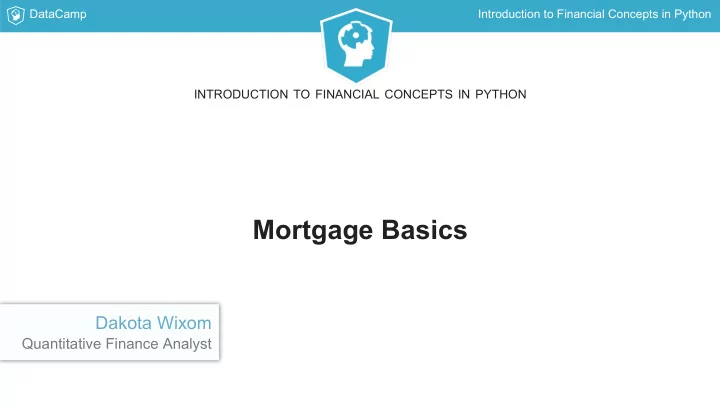

DataCamp Introduction to Financial Concepts in Python INTRODUCTION TO FINANCIAL CONCEPTS IN PYTHON Mortgage Basics Dakota Wixom Quantitative Finance Analyst
DataCamp Introduction to Financial Concepts in Python Taking Out a Mortgage A mortage is a loan that covers the remaining cost of a home after paying a percentage of the home value as a down payment . A typical down payment in the US is at least 20% of the home value A typical US mortgage loan is paid off over 30 years Example: $500,000 house 20% down ($100,000) $400,000 remaining as a 30 year mortgage loan
DataCamp Introduction to Financial Concepts in Python Converting from an Annual Rate To convert from an annual rate to a Example: periodic rate: Convert a 12% annual interest rate to 1 the equivalent monthly rate. = (1 + R ) − 1 R N Periodic Annual 1 (1 + 0.12) − 1 = 0.949% monthly rate 12 R: Rate of Return (or Interest Rate) N: Number of Payment Periods Per Year
DataCamp Introduction to Financial Concepts in Python Mortgage Loan Payments You can use the NumPy function .pmt(rate, nper, pv) to compute the periodic mortgage loan payment. Example: Calculate the monthly mortgage payment of a $400,000 30 year loan at 3.8% interest: In [1]: import numpy as np In [2]: monthly_rate = ((1+0.038)**(1/12) - 1) In [3]: np.pmt(rate=monthly_rate, nper=12*30, pv=400000) Out [3]: -1849.15
DataCamp Introduction to Financial Concepts in Python INTRODUCTION TO FINANCIAL CONCEPTS IN PYTHON Let's practice!
DataCamp Introduction to Financial Concepts in Python INTRODUCTION TO FINANCIAL CONCEPTS IN PYTHON Amortization, Principal and Interest Dakota Wixom Quantitative Finance Analyst
DataCamp Introduction to Financial Concepts in Python Amortization PP: Principal Payment Principal (Equity) : The amount of your mortgage paid that counts towards the MP: Mortgage Payment value of the house itself IP: Interest Payment Interest Payment R: Mortgage Interest Rate (Periodic) = RM B ∗ R IP RMB: Remaining Mortgage Balance Periodic Periodic Principal Payment = M P − IP PP Periodic Periodic Periodic
DataCamp Introduction to Financial Concepts in Python Accumulating Values via For Loops in Python Example: In [1]: accumulator = 0 In [2]: for i in range(3): ...: if i == 0: ...: accumulator = accumulator + 3 ...: else: ...: accumulator = accumulator + 1 ...: print(str(i)+": Loop value: "+str(accumulator)) 0: Loop value: 3 1: Loop value: 4 2: Loop value: 5
DataCamp Introduction to Financial Concepts in Python INTRODUCTION TO FINANCIAL CONCEPTS IN PYTHON Let's practice!
DataCamp Introduction to Financial Concepts in Python INTRODUCTION TO FINANCIAL CONCEPTS IN PYTHON Home Ownership, Equity and Forecasting Dakota Wixom Quantitative Finance Analyst
DataCamp Introduction to Financial Concepts in Python Ownership To calculate the percentage of the home you actually own ( home equity ): E Cumulative , t Percent Equity Owned = P + Down t V Home = ∑ t =1 T E P Cumulative , t Principal , t : Cumulative home equity at time t E Cumulative , t : Principal payment at time t P Principal , t : Total home value V Home : Initial down payment P Down
DataCamp Introduction to Financial Concepts in Python Underwater Mortgage An underwater mortgage is when the remaining amount you owe on your mortgage is actually higher than the value of the house itself.
DataCamp Introduction to Financial Concepts in Python Cumulative Operations in NumPy Cumulative Sum In [1]: import numpy as np In [2]: np.cumsum(np.array([1, 2, 3])) Out [2]: array([1, 3, 6]) Cumulative Product In [1]: import numpy as np In [2]: np.cumprod(np.array([1, 2, 3])) Out [2]: array([1, 2, 6])
DataCamp Introduction to Financial Concepts in Python Forecasting Cumulative Growth Example: What is the cumulative value at each point in time of a $100 investment that grows by 3% in period 1, then 3% again in period 2, and then by 5% in period 3? In [1]: import numpy as np In [2]: np.cumprod(1 + np.array([0.03, 0.03, 0.05])) Out [2]: array([ 1.03, 1.0609, 1.113945])
DataCamp Introduction to Financial Concepts in Python INTRODUCTION TO FINANCIAL CONCEPTS IN PYTHON Let's practice!
Recommend
More recommend